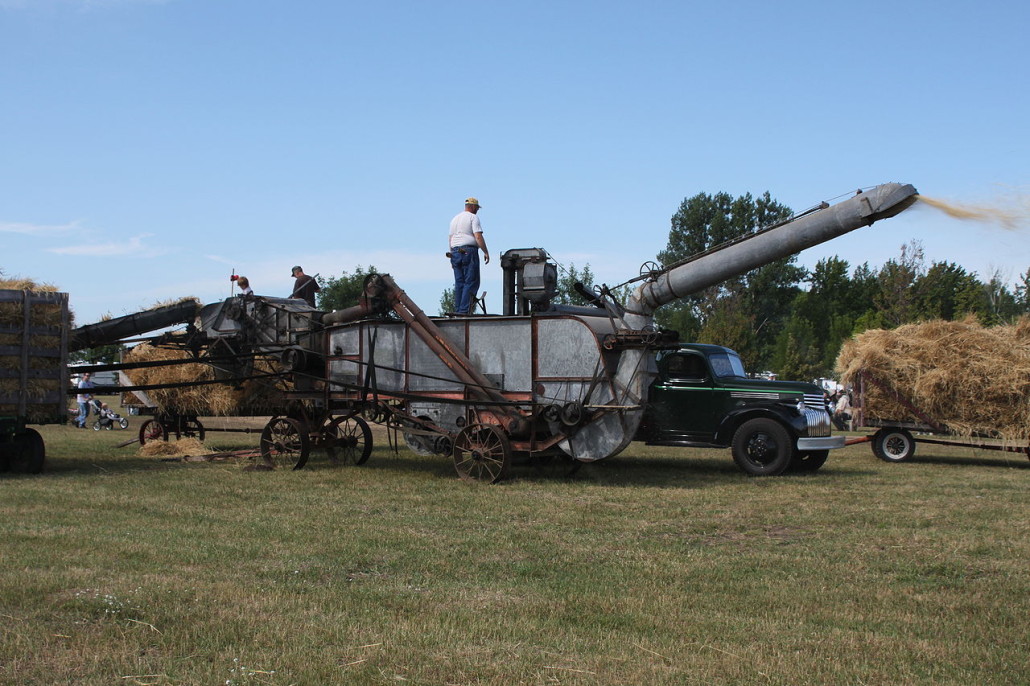
TOLEDO, Ohio (AP) – At Lee Lashaway’s Perrysburg Township farm, the smell of sweet corn and butter drifted through the air, while a long line of people snaked through the front of the field in wait of bean soup.
But if you looked past the crowd, you’d see rows and rows of antique yet functional gas engines and tractors, as well as a crisscross of motors and belts in motion across the field. And behind that, streaks of smoke on the horizon marked the main draw of the Five Point Steam Threshers Reunion this year: people threshing wheat the old-fashioned way, with steam engines.
“We’re mostly a group of neighbors who get together to thresh wheat,” said the group’s vice-president, Jason Hall.
At their 56th annual reunion, the threshers numbered between 50 and 60. The Five Point Steam Threshers is a largely informal organization, Mr. Lashaway said, and it considers any able body willing to help thresh the wheat as part of the group.
This year, the group has worked its way through five acres of wheat. The threshers sell the grain, but monetary income is only an afterthought.
Most of the machines out and about were built between 1900 and 1930, said Tom Deverna, who has been helping out with the Five Point Steam Threshers for a few years.
And they’re still going.
Hall showed off an example: his homemade Doodlebug tractor, built from a modified car chassis when new tractors were hard to come by in World War II.
Lashaway has been involved with the group since his father-in-law first bought a steam engine in 1975 and joined the yearly gathering of people – machinists, farmers, and antique tractor enthusiasts – who have settled on harvesting wheat with their old machines as a hobby.
“If it wasn’t a hobby, we wouldn’t do it,” Lashaway said. “It’d be too much work.”
Eight full-sized steam engines were put to work, while about 60 antique tractors roamed the event. Mr. Lashaway estimates that on a good year, 1,000 to 1,200 attendees flock to the reunion, which charges no admission.
“Evidently, it’s going to be a good year,” Lashaway said, surveying the event. “It’s not 100 degrees, there’s a nice breeze, and the crowd’s tremendous.”
Families and children milled about, observing the piles of wheat chaff growing alongside the roar of the engines. A steam engine hand-operated by Lashaway’s granddaughter, Dana, wove through the crowd.
Other people parked their tractors and enjoyed ears of corn, cooked to perfection by the steam of an engine. Beth Lashaway, Lashaway’s daughter-in-law, said the event sells about 65 dozen ears a year.
Though several attendees admitted that the best part of the reunion was the famous bean soup, others arrived to relive memories and observe the workings of history.
Watching the old machines reminded Elmore resident Myron Giesler, 87, of working in wheat fields as a child, he said.
“When I was a kid, I worked on those separators,” he said, gesturing behind him to the machines.
The event also featured plowing demonstrations and a children’s pedal tractor pull in the afternoon.
___
By MICHELLE LIU, The (Toledo) Blade
Information from: The Blade, http://www.toledoblade.com/
Copyright 2016 Associated Press. All rights reserved. This material may not be published, broadcast, rewritten, or redistributed.
AP-WF-07-24-16 1944GMT



